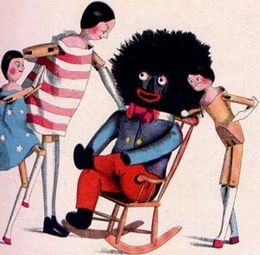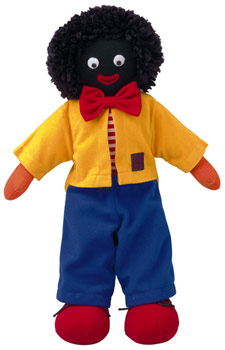
Turns out the inky black Rufty Tufty was just the tip of the golliwog iceberg [Oh wait.] Golliwoggs, as they were originally spelled, became a wildly popular staple of British kid life for most of the 20th century.
In 1895, a young English author/artist named Florence Kate Upton wrote The Adventures of Two Dutch Dolls and a Golliwogg, which starred the minstrel show doll she had played with a few years earlier during her childhood in the US. So Rufty Tufty is like a pickaninny version of Isabel Archer, the exotically naive American abroad. Or something.
Upton's book was a hit; she was able to pay for art school after all. A series was launched, but the Uptons didn't trademark the Golliwogg, and Golliwog and Gollie copies flourished for decades. After teddy bears, a gollie was the bedtime companion of choice for generations of British kids. White kids, that is. The biggest producer of Gollies was Steiff; the company even produced golliwogs are recently as 1995, the 100th anniversary of the character's introduction. [DT reader Adam even spotted a gollie sitting on that sweet cardboard kid's furniture that was featured here a couple of weeks ago.]
In 1910, Golly became a mascot for Robertson's jam, and millions of Golly pins--the Cracker Jack prizes of the British Commonwealth--were collected, traded, and hoarded by jam-addled Brits everywhere. [They still are. This snap is just a fraction of the collection at gollycorner.co.uk.] Robertson's only retired Golly in 2001.

Taken out of their original, slave/segregation American context, the racism of golliwogs seems more British imperial/colonial; it's more complicated, perhaps, but not necessarily any less offensive. And Craigie's Nicky and Nigger titles and other golliwog books by Enid Blyton, for example, exhibit plenty of obvious racism which seems even more offensive for turning up in a cutesy kid's book.

And yet the marmalade-n-pin thing has to have created a lot of non-racially tinged associations of childhood nostalgia, too. This seems like a more likely context for the emergence of Malfi, the Friends With You doll which, from seeing the shape and all the non-black versions together, I first read as penguins, not minstrels.

I'm sure the wholesome, innocent nostalgia rationale is in full gear when companies make Gollies in dozens of variations today, too, but I have to say, that feels much more problematic. [What's up with this one, for example? It has white hands. Does that mean it's actually a white doll in blackface?]
I got a lot of insight from the Golliwog article at The Jim Crow Museum of Racist Memorabilia [ferris.edu]
Handmade Golly rag dolls by Kate Finn, $AU30-80 [katefinn.com.au]

I have purchased those dolls in OZ as baby gifts for my American friends. My response regarding the golli with the white hands would be that Gollis wear gloves a la minstrels - but those hands pictured aren't white-they are pink! I think you had better ask Kate Finn herself!
I made a golli for my firstborn- sadly for me she never did show any interest in it.
We learned about Golliwogs from an episode of Ricky Gervais' new series "Extras." (We like to watch educational TV from Netflix after the kids go to sleep). We were not inspired to run right out and buy one for the kids, but it was a good episode.
As a black child growing up in the 70's in the UK the golliwog was a source of shame. It seemed to be an axe that was held over my head constantly by white children and adults. If I acted to smart , if I said anything they didnt like I could easily be whipped into place by being called a golly , golliwog or wog. One of my white friends even told me she had a golliwog and named it after me.
Ruth Ainsworths rufty tufty was a popular book when I was growing up and in the book it cites that the Golliwogs loved to hear stories about children with their white skin, rosey cheeks , fair hair and blue eyes. So those of us who didnt look like that were not human at all but golliwogs. In. the same story rufty tufty tries to pass himself off as a human by smearing cold cream on his face and talcum powder. He sticks a hat over his head to hide his fuzzy hair and covers his black hands with gloves. in order to pretend he is a human ( white)
I found it was alot to take on board as a child and now as an adult, that a race of people had created a character to lampoon me and then told me to fit in with the white majority, who would be oblivious to not only my opinions , but also my experiences and reality.
Enid Blytons gollies were called Golly, woggie and n**ger and had an aunt coal black. Golly Smith another famous children's character who was part human and part golly put a turban on his head to disguise himself as an indian mahout , it fell off. He ended up being put in the zoo where the crowds threw bananas at "his black head"
I do not own a golliwog, but collect various golliwog books now. They were not design out of innocence or naievity, but pure hatred. At the time blacks had no vote or rights. Grown men were called boy and you could be lynched by any white person simply for speaking back.
If it is part of white culture to have them so be it, but I ask myself why you need to be like this. I had white dolls and black dolls as child , I certainly didnt have any creature lampooning the white race and I am a supposed to be the racial inferior.
[wow, thanks for the powerful perspective, Gerry. I think a lot of interest in or acceptance of Golliwogs is due to nostalgia, tradition, and peoples' own rather selective childhood memories. That said, I would bet that the vast majority of white folks also have never heard, asked, or considered the POV of non-white children or adults on the matter. It's clear that Golliwogs and Gollies and Wogs all accumulated racist and even spitefully derogatory connotations along their history. Considering the racist attitudes and common wisdom that prevailed at the time, it was inevitable. -ed,]
I grew up in england in the 70s. I am white and own a couple of golliwogs and pins. I think that they are a terrible depiction of the black population. But so are cabbage patch kids and barbies. Especially Barbie. As a whit child I grew up thinking that I needed to look like barbie to be accepted, No white girl looks like a barbie. If a real womwn had the same measurments as barbie, they would have a rib removed. All cultures have things that aren;t a nice thing, but it is part of our culture, like it or not. I love my golliwog, to me it reminds me of my childhood, not a black person. Its just a doll I had whlie growing up,
I am a white american who grew up in the 80's. I never knew about golliwogs when I was still young enough to enjoy stuffed toys. I first came across the word while flipping through the dictionary. As a child I can remember very well that my interest in this character was due to its unusual name, which I still find fun to say. In the dictionary it said that a golliwog was an ugly black doll from a children's book I had never heard of. I never thought about the implications of the doll's color. I thought nothing of race. To me the doll was another creature quite distinct from humans. It was not a human, it was a golliwog. Now that I understand the history of the doll: how it was inspired, what children were being taught through it's false and exaggerated appearance and how they would use the doll to taunt children of another race, I was very bothered. And yet I still find something appealing about the golliwog. I try my hardest to view it as anything but a grotesque charicature of black people, and I wish there was some way to keep the fond nostalgia of the character without promoting the racist thinking in which the original golliwog was made.
I had a home made golly given to me as a child in England during the 70's. I never once regarded this toy as anything other than a cuddly toy that gave me comfort. Looking at the history of the golly, it was first brought to the public's eye in the arly part of the 20th century by Florence Upton. The character she created, was noble, a friend to the other characters and their protector. She said of him, he was born out of no dark intentions, 'just that I walked with him through childhood'.
I can easily understand the racial connection, especially in this politically correct environment we live in, but whatever the present opinion of the golly, the fact remains that he has given comfort and love to thousands of children over the decades, children who loved him and never once connected him to racial stereotypes. Again Upton remarked on hearing her character was ugly, with 'children can see the beauty that is within him'
I believe that the negative qualities have been bestowed upon the character by those not fully understanding him.
While living in the Caribbean, there was a great number of ethnic rag dolls sold in lOcal craft shops, some in bright clothes, or with dreadlocks and beads in their hair, is this not also a racial stereotype? Yet I never heard of any complaint.
My daughter who is 4 years old, who also lived with us in the Caribbean has had a hand made golly since she was born. She has loved her toy and taken him with her on holiday, and was heartbroken when she lost him on a recent trip, does the fact that she has owned and loved a golly make her a racist? I think the answer is easy: no.
What makes a person racist, is ignorance, not cuddly toys, which are only that, toys.
Here Here! Could not have put it better myself!